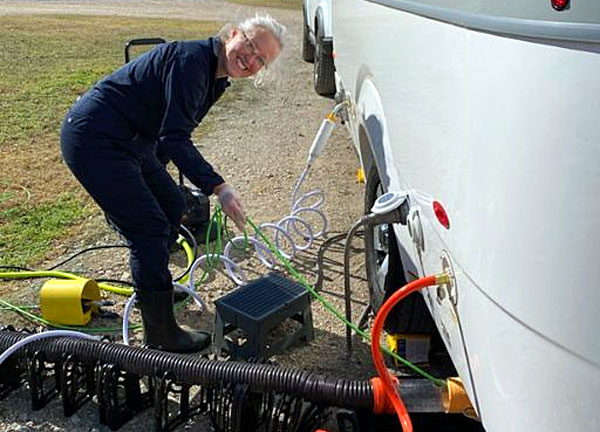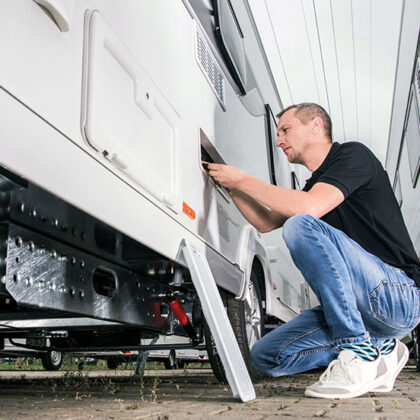
by Greg Gerber
“Something stinks in here!” If you’re a Workamper, you’ve probably said this more than once while trying to control odors in your RV. The source of these unpleasant odors is often a garbage can, a rodent in the basement, or an untreated holding tank
Sue Rasmussen, owner of Royal Flush RV, knows this all too well. Her company specializes in keeping RV holding tanks in top condition, effectively controlling those stubborn tank odors. When Sue started RVing, she planned to do it for just a year. However, by the time she sold her RV at the end of 2023, she had enjoyed the lifestyle for eight years.
Three years ago, Sue’s curiosity about the inner workings of her RV led her to the National RV Training Academy in Athens, Texas. There, she realized the pressing need among RV owners to maintain clean holding tanks.
“Of all the things I could specialize in, I chose cleaning black and grey holding tanks,” Sue explained. “It has turned out to be a lot of fun. People are happy and grateful when I’m done.”

A Common Misconception
Many RV owners feel the source of tank odors comes only from the black holding tank, which handles waste from toilets. They’re wrong.
“After cleaning thousands of RV holding tanks, I can tell you with certainty that grey tanks often smell worse than black ones,” Sue explained. “That’s due to everything going into them.”
While many people think gray water tanks only contain water and soap, they also hold hair, skin, lotions, grease, fat, coffee grounds, food particles, oils, and sticky substances.
“All that stuff either turns rancid or ferments in grey tanks,” she added. “Anything that goes into the tank will start developing bacteria and eventually turn to black mold.
A lot of people consider what to add to their tanks to reduce odors. But I take a different approach to look at what we can prevent going into tanks in the first place,” Sue explained. “Then we need to look at what to use to take care of the tanks themselves.”
One of the easiest things people can do is to scrape off dishes into a garbage can and wipe them off with a paper towel before washing them.
“A lot of people use things that smell like lavender or citrus to cover up the smells,” she added. “I would rather neutralize the smell than simply cover it up.”
Tank Treatments
It’s impossible to control what goes into the black tank because it’s designed to hold human waste. So RVers shouldn’t worry about controlling what’s going into the black tank, but rather neutralizing what’s in it.
When selecting a holding tank treatment, it is important for RVers to consider the product’s impact on a campground’s septic system. Many tank treatments consist of chemicals that work to kill bacteria causing odors, but ultimately kills all bacteria in the campground’s septic system, too. Septic systems rely on bacteria to break down waste. Without it, waste can accumulate and cause expensive backups.
“You want to keep your RV’s holding tanks working well, but also ensure that what you flush from your tanks doesn’t damage the septic or water system at the park,” Sue said. “It can cost a campground thousands of dollars to fix a problem caused by dumping the wrong things into the septic system.”
That applies not just to products added to holding tanks, but also to toilet paper that won’t easily breakdown in a septic system. She recommends Scott-brand, septic safe toilet paper, although any paper works as long as it’s marked as “septic safe.”
“It’s a huge mess and a huge expense for a campground to have to pump everything out of their system and fix damaged pipes,” she explained. “Besides, many of those chemicals contain ingredients that can damage the RV’s own plumbing system.”
For example, certain chemicals don’t break down toilet paper; instead, they crystallize it into a solid as hard as a brick. Other treatments may break down material, but include fragrances and dyes, which aren’t always good for your tank or the environment.
Use a Probiotic Tank Treatment
Sue recommends people look for treatments that use a probiotic, which does a good job of neutralizing odors without the need for other chemicals. She doesn’t make money by recommending products, but she notes that people who use probiotic treatments will not need to have their tanks professionally cleaned as often.
Personally, Sue uses TankTechsRX, which is sold by a company called Just Science.
“When I first got into tank cleaning, I did a lot of research and I like their products because it contains only a probiotic and molasses, which serves as food for the probiotic,” she explained. “It’s brown and doesn’t actually smell good in the bottle. But, once you put it in the tank, it does a very good job at neutralizing odors.”
Sue spoke with the owner of the company and learned the product was initially developed to neutralize odors in pig slaughterhouses. She encouraged the company to develop something specifically for use in RVs.
“People can use TankTechsRX in their RVs, boats and private septic systems,” she explained. “When you flush your holding tank with TankTechsRX in it, you are actually helping the park. The probiotics continue to grow and breakdown waste in the park’s system, too.
“I tell people it works like a sourdough starter. When you dump your tank, you need to leave a little material in it so the probiotics will continue to grow,” she added. “After dumping your tank, add a little bit of TankTechsRX to feed the probiotics already in your tank.”
The product needs to be flushed down the toilet each time the tank is dumped. It also needs to be poured down the sink drain. That way, both the grey and black tanks get treated.
Some people, especially families, take a lot of showers and need to flush their gray tanks every day. In those cases, Sue recommends adding TankTechsRX to the grey tank, but letting it sit overnight, or for a few days, if possible. That way, the probiotics have a chance to work their magic on the tank.
Some other tank treatment products use chemicals that could be harmful to children or pets. Another concern is that chemicals can concentrate in the confined spaces of an RV, making it easier to breathe them into your lungs.
Keep Tanks Closed
Unless you have a dishwasher or washing machine in your RV, for which the manufacturers require grey water tanks to be open when in use to prevent overflowing, RVers should leave their holding tanks closed until they’re ready to dump them.
Leaving the valves open all the time works to cause serious damage to RV holding tanks, especially in the black tank, Sue explained. An open valve can also be an open door to unwanted guests.
“People don’t realize there are things that live in septic systems that can crawl into your tank and, from there, up the drains,” she added. “There are everything from bugs to pods that can get into your system. I have even talked with other tank cleaners who have encountered snakes in RV holding tanks.”
Leaving black tank valves open all the time works to create what is commonly referred to as a “poop pyramid.” Not only is it stinky, but the waste can literally turn into cement that may require replacing a tank.
“All the water will run out of the black tank, leaving waste material and toilet paper behind,” Sue said. “It is going to be cheaper to take the RV to a repair center to have the old tank replaced than it will be to hire a professional cleaner to try to clear out a poop pyramid. Either way, it is a very expensive repair.”
Professional Cleaning
When to get holding tanks professionally cleaned will depend upon several factors, such as:
- Number of people using the RV
- Age of the RV
- Whether best practices for holding tank treatments are followed

“When I clean a tank, I can never tell what’s going to come out and how much,” Sue said. “I had a brand new RV where the owner was meticulous about treatments, but had some of the filthiest tanks I have ever seen after six months of use. I had another customer with a five-year-old Class A and their tanks were almost pristine.
“As a general rule, I recommend that people have tanks professionally cleaned every 12 to 18 months,” she explained. “If you are buying a pre-owned RV, I’d recommend having the tanks cleaned soon just to clear out all the material that may have been left behind.
“There are too many factors to be able to give a one-size-fits-all answer. It depends on the plumbing, tank treatment products, what they eat and even personal health of the owners,” Sue said. “I am always going to teach people how to care for their own tanks to help extend time between cleanings.”
Make Money Cleaning Tanks
Because all RV owners need to have tanks professionally cleaned every few years, Sue said there is an opportunity for people to make good money by learning how to clean tanks properly.
“I have an online training program that teaches people basically everything they need, from start to finish, to set up a professional tank cleaning business,” Sue said. “I describe what kind of equipment they need to get started, and how to market their services.”
She established a network of graduates of her program to help handle referrals. Professional cleaners can also be listed on the RV Technician Association of America website at www.rvtaa.org and set up their profile to show their current location and contact information.
To connect with Sue to get your tanks cleaned or for more information about becoming a professional tank cleaner, visit www.royalflushrv.com.
Thanks for reading the Gone Workamping blog from Workamper News. Join Workamper.com today to see all the new job opportunities for RVers, as well as the training and resources to confidently find the right Workamping job for you – easily and securely.






